
 |

|
|
|
|
Height:
6' (183 cm) Weight: 170 pounds Eyes: brown-topaz Hair: dark Marriage: Helene L. Rosson, writer and radio interviewer (Feb 22. 1941 - Dec 25. 1979, his death). Helene was Victor Fleming's stepdaughter and from 1933 to 1935 married to Jaime Del Valle. Son: Lucien Lee Bowman III "Beau" (Oct 19. 1943), Stepdaughter: Helene Del Valle Harper (Apr 4. 1934 - Jan 12. 2000) Siblings: Pringle Clarke Bowman (1917 - 1937) Andrew Hunter Bowman (1921 - 2006) |
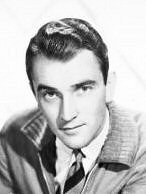 |
| Above right: Lee Bowman in 1935. | |
|
Born as Lucien Lee Bowman
Jr. December 28. 1914 in Cincinnati, Ohio (USA).
His thrice-married mother, Elizabeth "Bessie" Pringle Brunson Fauntleroy Bowman
Clyde, grew up as Southern aristocracy on Kingstree, the Brunson family
plantation outside Charleston, SC. But there was a hex on Bessie's private life. Both her mother and her grandmother would fatally burn - in 1912 in accidents with a fireplace and an overheated stove, respectively. And her first husband Dr. Thomas T. Fauntleroy of Staunton, Virginia, a dentist and mineral-water entrepreneur from Staunton, Virginia, contracted a debilitating illness. Her second husband, Luther Lee Bowman, also was from a Staunton family who owned a department store and hotel. Luther Bowman, who was active in harness racing, started a local department store himself in 1912 before moving Bessie and his sons to Cincinnati in 1914 to start the brewery with his brother, when it failed, he became an income tax collector. He died in the mid-1920s. Bessie Clyde died in 1967, age eighty-four. Bessie bore her second husband, Luther Lee Bowman, three sons: Lee, Pringle, and Hunter. |
|
| After that marriage fell apart, Bessie married a wealthy distant cousin, William Clyde supported Lee's pursuits of singing and dancing at the Cincinnati Conservatory of Music as well as varsity athletics (gymnastics and track) in public school. After attending Franklin Grade School, Lee graduated from the Walnut Hills High School in Cincinnati. While Lee was attending high school, his sister, Rowena, met with some success on Broadway, which at that time strangely had little effect upon her brother's ambitions. Colleagues remembered his prowess in ice hockey, baseball and track. Lee befriended the Cincinnati native Tyrone Power, and in state track meets challenged the future fastest man in the world, Cleveland's Jesse Owens. Nevertheless Lee enrolled as a law student at the University of Cincinnati. Since his parents descended from a long line of lawyers, judges and ministers, this didn't come as a total surprise. | |
| Lee could not divorce the idea of an acting career. When Bowman entered Columbia University* in 1932, he was bent on lawyering. Fred Astaire movies changed his life. "If he can do it, I can do it". Reportedly when he left the theater, he had a fierce ambition, he was going to be an actor. He reasoned that, if anyone could improve in acting within a few years as much as the star of the film he had just seen, actors must be made and not born. That night he talked the whole question over with his mother; he wanted to leave law school at once and start training for his new career. Finally, she said: "Go ahead, Lee. You've got the enthusiasm. And I believe you have the talent." He promptly enrolled at the American Academy of Dramatic Arts. He studied there for two years. | |
|
So began a career as a stage actor and radio
singer in the '30s. Following several years of stock, Lee entered a
partnership as part owner of a New Hampshire stock company. In New York while attending dancing school operated by one of the Condos Brothers Lee was approached by an agent who'd caught his dancing. He asked him if he wanted to Rio de Janeiro to star in a big club. Lee hesitantly said "I don't know..." "Don't ever say that!" his dancer girlfriend scolded afterwards. "Say you can do anything. Let them tell you you can't!". Though he didn't go to Rio, that motto stuck. So when after months of marching from casting-office to casting-office he finally ran into his first chance this motto became handy. He was to play the singing lead in a series of big-time radio broadcasts. He neglected to confide he couldn't sing a note. In the next two days, with the aid of a singing teacher he learned to sing. However at the final tryout Lee was outplayed by the clarinet player he had hired to accompany him. His performances in the stock company did result in him being signed to (briefly) play the lead as "Peter Standish" in de Carnegie Players production Berkeley Square (Old Empire Theatre, 1936) in New York. Another top role next to Kate Mayhew in The Old Lady Shows Her Medals followed. Talent scouts caught him in this, and the next year saw him in Hollywood making his film debut in movies such as Internes Can't Take Money (Paramount, Apr 16. 1937) and I met Him in Paris (Paramount, May 28. 1937) a romantic comedy starring Claudette Colbert, Mervyn Douglas, and Robert Young. At age nineteen he had a Paramount contract. Following this he spent seven years playing second leads, often as a playboy thanks to his suave, elegant style and dapper, handsome looks. On January 31. 1937, his 20-year-old brother, Pringle Clarke Bowman, died at Bellevue Hospital in New York from knife wounds sustained during an attack in Harlem. After two years with Paramount (1937 - 1938) he went to RKO where he was dropped after five films (1938). Metro-Goldwyn-Mayer now signed him to a long term-contract (1939). |
|
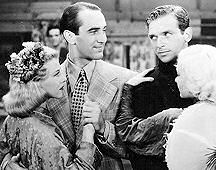
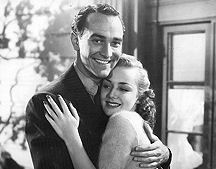 Above left: (L to R): Ginger Rogers, Lee Bowman, Douglas Fairbanks Jr. and Dorothea Kent in RKO's Having a Wonderful Time (RKO Radio Pictures, Jul 1. 1938) Above right: A Man to Remember (RKO Radio Pictures, Oct 14. 1938) Lee Bowman with Anne Shirley. |
|
|
In November 1938 actress Joy Hodges and Lee announced their engagement following a romance of several weeks. The wedding date will be held in abeyance pending a free period from film work. She even announced to be married "about Christmastime". The wedding would take place in Miss Hodges' Beverly Hills home. However Lee remained a bachelor. For a while after his broken engagement Lee became a permanent fixture at the Trocadero. His name is every column with every actress in Hollywood. Women liked not only his personality, but his dancing, tennis, and badminton prowess. West of the Rockies he was almost a champion at all three of these activities. Not only Lana Turner, Joan Bennett, Joan Crawford, Rosalind Russell and Norwegian film star skater Sonja Henie but also Wendy Barrie (Nov 1938) and Lee Bowman were reported as "composing one of Hollywood"s newest romances". However Cupid's arrow struck target when Helene Fleming and Lee first met at the West Side Tennis Club in August 1939. Lee's younger brother Hunter, who together with their mother lived with Lee in Beverly Hills, said, "Helen was a good tennis player and she was not stupid, she set her sights on Lee and got him.". After she beat him at tennis, he took her out to The Trocadero dancing and a different love game got underway. |
|
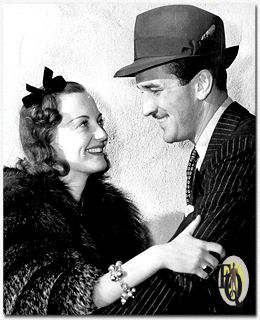 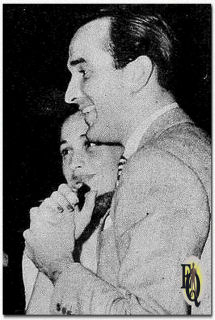 Above left: Actress Joy Hodges to wed actor Lee Bowman. Joy Hodges, popular Universal player, and Lee Bowman are looking altar-ward. The film players announced their engagement following a romance of several weeks. The wedding date will be held in abeyance pending a free period from film work (International News Photo La Bureau, Nov 17. 1938). Above right: Lee Bowman with Helen Del Valle (Nov 1939). |
|
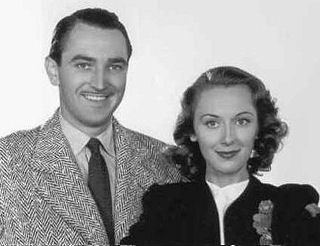
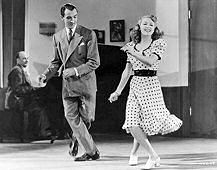 Above left: In M-G-M's Stronger than desire (MGM, Jun 30. 1939) he played opposite Virginia Bruce and Walter Pidgeon, with whom he is often mistaken on photo credits. Above right: Dancing Co-Ed (MGM, Sep 29. 1939) with Lee Bowman & Lana Turner. |
|
|
Helene was director's Victor Flemings stepdaughter and
they had not been able to get his approval for their relation. After going together for two years,
in 1941, they quarreled and
decided to break it all off. All was over between them. And Helene, feeling
pretty blue, was going away to Honolulu to "forget" him. So Hoagy Carmichael,
a good friend of theirs, thought it would be nice to have a going-away party
for Helene and invite Lee just so they'd be together one last time. At the party (Feb 21. 1940) Lee and Helene weren't aware other guests were even there. They just sat and stared at each other. Finally he asked her if she'd marry him when she got back from forgetting him in Honolulu. That didn't seem to make sense. So he said, "What about marrying me tomorrow?" Then, a little later, "What about right now?". Not wanting to break up the party, they threw their coats out the window and then casually eloped out the door after them. In a pouring rain, they headed for Tijuana, Mexico - only to find that there was a three-day marriage law there. But some little Mexican boy told them he had an uncle who was mayor/justice of peace in a nearby Mexican village Tecate. "My uncle will marry you, Senor," he said confidently. Cold, wet, and disappointed, they drove on and were married by the uncle at about 4:30 in the morning. The entire ceremony was in Spanish, and Helen said she kept saying "Si...Si" in all the wrong places. She never knew what she promised Lee she'd do, but there wasn't a "No" in the lot. |
|
| Near the end of May 1941 Bowman decided to send seven-year-old "little Helene" his wife's daughter from her first marriage to Ojai for boarding school. Victor Fleming felt the child was getting short shrift from her mother and stepfather. He already thought she spent more time with nannies than with them, so they could attend their social whirl. Lee and Helene weren't allowed on Fleming's property ever again. Although little Helene and Lee Bowman Jr., born in 1943, did come for visits. | |
 Above: Judy Garland and David Rose at the Westside Tennis Club Dugout Party with Mr & Mrs. Lee Bowman (Oct 31. 1942). - (JudyGarlandExperience) |
|
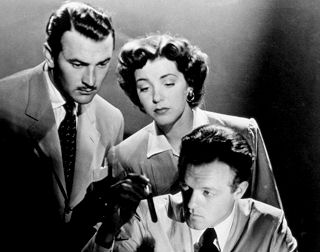
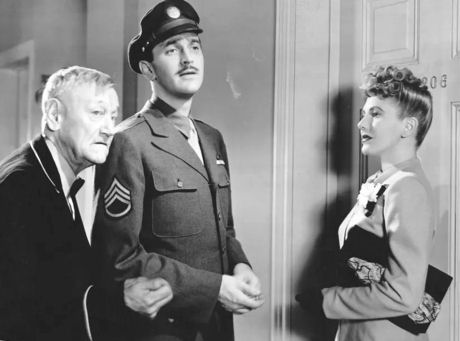 Above left: Fred Zinnemann's feature debut Kid Glove Killer (MGM, Apr 17. 1942), a neat, an enjoyable whodunit about the hunt for the killer of the town's crusading mayor. Van Heflin, as the dedicated forensic scientist, demonstrates a mini-dustette to collect evidence from human scalps. Marsha Hunt plays his wisecracking assistant who despairs of his ever realizing that she's a woman, and Lee Bowman as the blandly suave killer. Ava Gardner has a tiny role as a waitress. During a fight scene between Van Heflin and Lee Bowman, Fred Zinnemann had to cut the scene and start over because both of the stars toupees came off! Above right: Jean Arthur and Lee Bowman in The Impatient Years (Columbia, Sep 7. 1944) showing the reality behind wartime marriages ... Also in this photo Charley Grapewin! |
|
|
He left M-G-M after five years. Bowman had
complained to Louis B. Mayer constantly about always being cast as second lead.
Mayer suggested he might be happier elsewhere. He was - at Columbia. Harry Cohn
gave him top billing, but in movies that were seldom of top quality. The Bowmans lived just two blocks from the Pacific, in Santa Monica, in an old fashioned dark brown single house with gables, an old weather vane on top, a bright cheery red front door. It was decidedly a dismal-looking place, when they bought it in June 1944. But Lee loved to work around the house, and Helene was an excellent interior decorator. They came up with a warm, charming home that looked a lot like Lee's old home in Cincinnati. Never a major star, he began concentrating more on his stage work in the late '40s. As many celebrities do, he also had several guest roles on radio (and subsequently on TV). He was heard on The Old Gold Comedy Theatre, episode "Vivacious Lady" (NBC, Nov 19. 1944, min. 1), an adaptation by Malcolm Meechan where Bowman was heard opposite Harold Lloyd and Linda Darnell. On radio he was also heard in The Lady Esther Screen Guild Theatre with Paulette Goddard (CBS, Nov 27. 1944), Inner Sanctum (CBS, Jan 23. 1945, min. 1), several episodes of Suspense (CBS, Mar 30. 1943 - Dec 6. 1945, min. 4) and The Cavalcade Of America (NBC, Nov 18. 1946 - Mar 10. 1953, min. 13). |
|
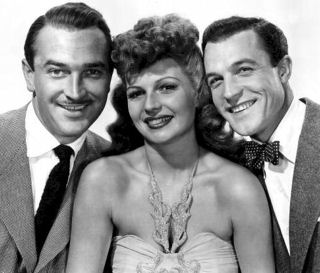
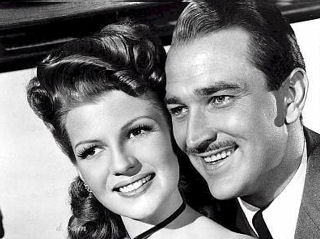 Above left: With the tagline "Too thrilling for words, so they set it to music! " Cover Girl (Columbia, Mar 20. 1944) hit the screens, it starred Rita Hayworth, Lee Bowman and an energetic Gene Kelly. Above right: In Tonight and Every Night (Columbia, Jan 9. 1945) a photographer for Life magazine comes to London to do a story on a local theater troupe which never missed a performance during World War II. Flashbacks also reveal the backstage love affair between star Rosalind Bruce (Hayward) and a British flyer played by Bowman. |
|
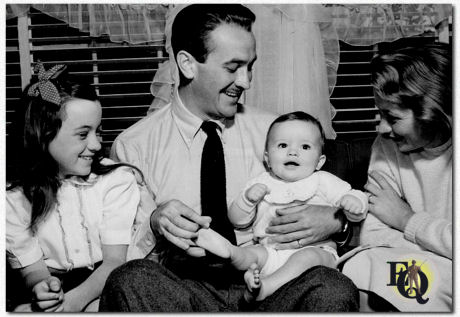 Above: Interior shot in the Westwood Hills bungalow of the Bowmans. From left to right, girl scout Helene has her mother's name, Lee Bowman with Lee Bowman Jr. and Mrs. Helene Bowman (May 1946) (Toronto Star Archives) |
|
|
In the fall of 1946, George Murphy, the song-and-dance
man who became a Republican senator from California, invited Bowman to make
a speech in Whittier for “some young guy named Dixon or Nixon”
running for Congress from a district that included San Dimas. “Murphy
suggested he take my mother along and make a day out of it,” Lee Bowman
Jr. recalls. “My mother replied, ‘Go to Whittier for a speech? You’ve
got to be out of your mind! Call up your mother, she’ll go anywhere to
listen to you!’ So he and my grandmother went, Richard M. Nixon defeated
Jerry Voorhis, and the rest is history.” Bowman’s freshman congressman
of choice became an influential member of HUAC. The success of Columbia's Cover Girl wasn't left unnoticed and Hollywood teamed Bowman several times with the lovely Susan Hayward. Hit it big time in the mid '40s. In 1948 Susan Hayward got nominated for her role in Smash-Up: The Story of a Woman (Universal, Mar 11. 1947) The film loosely based on the life of Dixie Lee (wife of Bing Crosby) tells the story of a nightclub singer who marries a rising singer and falls into alcoholism when she gives up her own career. In this movie Bowman had difficulties working with Hayward. Between takes they barely exchanged a word. Bowman at the time made no effort to conceal his hostility toward Susan from the day the production started. "Of the many stars I've worked with," he later said, "she was the only one with whom I ever had any difficulty." Blaming it on her inexperience and the great pressure she was under. A great deal of difficulty, actually came from the fact that he was seething with resentment. When he had signed for the film, he had been certain it would make him a major star after ten years as an also-ran. After ten days of shooting, however, he no longer had any such illusions; he felt he was being shafted by Susan, by Heisler and by Walter Wanger. |
|
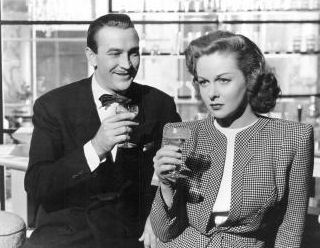
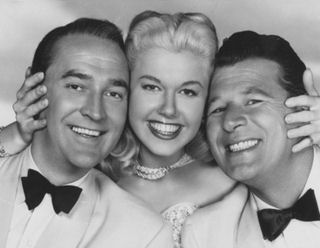 Above left: Susan Hayward got nominated in 1948 for her role in Smash-Up: The Story of a Woman (Universal, Mar 11. 1947) The film loosely based on the life of Dixie Lee (wife of Bing Crosby) tells the story of a nightclub singer who marries a rising singer and falls into alcoholism when she gives up her own career. Carleton G. Young (that "other" Ellery Queen) also had a small part in this movie. Above right: Lee Bowman, Doris Day and Jack Carson, a publicity shot for My Dream is Yours (Warner Bros., Apr 15. 1949). |
|
|
In the radio pilot for My Favorite Husband
(CBS
Radio Jul 5. 1948) Lee Bowman played George opposite Lucille Ball. They
got a positive response, however he had to bow out of the regular series due to
contractual obligations. He was replaced by Richard Denning. Although his father-in-law, Victor Fleming was the director, he couldn't land the role of the Dauphin in the Ingrid Bergman version of Joan of Arc (RKO Radio Pictures, Nov 11. 1948). Fleming said "I chose José Ferrer not only because he approximates a physical resemblance to the character, but because I knew he would attack the part with more enthusiasm than some actor who wished to return home to the swimming pool,"ť a rare public swipe at Lee Bowman. He also missed out on Flamingo Road (Warner Bros., Apr 28. 1949) when Joan Crawford preferred David Brian as her leading man. He lost a Bette Davis picture when the star thought he photographed too young. In House By the River (Republic, Mar 23. 1950) directed by Fritz Lang. Louis Hayward accidently kills his maid while trying to seduce her, and enlists the aid of his crippled brother (Lee Bowman) to dispose of her body. Bowman is blamed for her death when the corpse washes ashore later. Also with Jane Wyatt and Dorothy Patrick. |
|
|
On radio he was heard in 1950 in Theater Guild On the Air (aka
U.S Steel Hour) an anthology series which brought hour long dramas. In
A Life in Your hands, a murder melodrama and courtroom procedural
created by Erle Stanley Gardner Lee Bowman was one of the actors who played
Jonathan Kegg (in 1951). This fictitious hero represented neither the
prosecution nor the defense in the murder stories, but was allowed to
examine witnesses on both sides in order to learn the truth. Erle Stanley
Gardner only contributed his name. He briefly (80 episodes) starred in the TV series The Adventures of Ellery Queen (Dumont-ABC, 1951 - 1952) as Ellery Queen. "I find myself working forty hours a week on just the twenty-four-minute Ellery Queen show itself. Additional guesting on such shows as Theatre Guild of The Air, Studio One, Curtain Call, Cavalcade of America serves to add hours to my work week, and break up my weekends with the family. On top of that, I'm active in several other business ventures ... ." |
|
 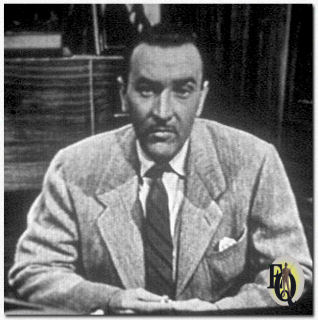 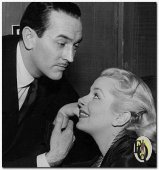 Above left: Lee Bowman stars in the title role of Du Mont's, thrilling series, The Adventures of Ellery Queen. Above middle: Lee in the Ellery Queen Adventure "The Red Hook Murder" Above right: Lee Bowman and Jean Carson in "The Man Who Killed Cops" (Feb 1. 1951) |
|
|
After the EQ series he stayed on the East Coast to do Broadway shows, front
TV spectaculars for an auto concern, supervising of his mother's 1,000-acre
farm in Kingstree South Carolina (cotton, tobacco and timber), conduct a
real estate-insurance firm with his brother, act as director of a commercial
film concern, perform on a weekly drama over NBC radio and appear on the
panel show, Masquerade Party. In the latter a panel of celebrities
met with another celebrity who was in heavy make-up and/or costume; this
disguise would always provide clues to the celebrity's actual identity. During his 1952 Eastern activity he was named "Best Dressed Man" and moved his household to a roomy home on Long Island (actually New Canaan, Conn.). Robert Montgomery Presents (NBC, May 8. 1950 - Oct 22. 1956, min. 8), Your Show of Shows (NBC, Sep 23. 1950, min. 1), Studio One (CBS, Nov 6. 1950 - Feb 8. 1958, min. 2), and Lux Video Theatre (CBS, Jun 11. 1951 - Sep 13. 1956, min. 3) helped to make Bowman one of TV's most popular performers. "Back in those days you were supposed to be either a movie actor or a television actor," he recalled. "If you went into a TV show, you were considered something of a traitor. About the only ones doing TV in those days were Ralph Bellamy, Robert Montgomery and myself". He hosted Eye Witness (NBC, Mar 30. - Jun 29. 1953, min. 12) a 30 minutes TV show. Lee also presented a TV game show called What's Going On? (ABC, Nov 28. - Dec 26. 1954, 5) which lasted only five weeks in late 1954. The six panelists were divided into two groups, the in's, who remained in the studio, and the out's, who went outside. The in's had to guess what the out's were doing. Bowman also hosted the NBC's Max Liebman spectaculars (aka Max Liebman presents or The Sunday Spectacular) in early 1955 which had 40, 000, 000 viewers. Lee felt the best work of his career was done as Nick Carraway in the Robert Montgomery presentation of "The Great Gatsby" (NBC, May 9. 1955). |
|
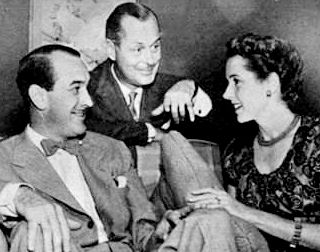
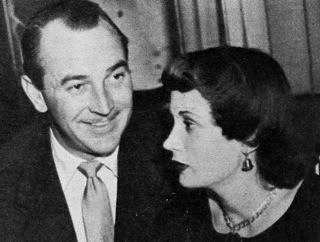 Above left: Robert Montgomery Presents, Lee Bowman, Robert Montgomery and Jane Wyatt. In the episode "The Awfull Truth'' Lee and Jane played Jerry and Lucy Warriner (CBS, Sep 11. 1950). Above right: Lee Bowman with his wife Helen Rosson in the Stork Club (1955). |
|
|
In the theater we played with Uta Hagen, Edith Meiser and
Robert Preston in The Magic and the Loss ((Booth
Theatre, Apr 9.
1954 - May 1. 1954), a play by Julian Funt and directed by Michael
Gordon made it's way after tryouts in Pittsburgh,... to Broadway where it
was performed 27 times, a flop. Oh, Men! Oh, Women
(Newport Casino Theatre, Aug 15. - 20. 1955) was performed in
Newport, R.I. and featured Lee Bowman, Judith Braun and John
MacKay. On May 13. 1958 Bowman was assaulted by a mugger on a midtown street in New York City. He suffered a sprained shoulder, knee scratches and possible toe injuries. Patate (Henry Miller's Theatre, Oct 28. - Nov 1. 1958) was a play which was written by Marcel Achard based on the book by Irwin Shaw. This comedy in three acts played on Broadway for a meager 7 performances and had Tom Ewell, Susan Oliver and Lee Bowman as a few of the members of the opening night cast. Jean Kerr's Mary, Mary with Patricia Smith, John Lasell was produced by Roger S. Stevens and directed by Joseph Anthony (Sep - Dec 1962). Bowman was one of the stars. (There was also was a New York and London cast for this play). "Mr. Lee Bowman plays the movie star the way a movie star should be played. It is quite evident that all his television side excursions have had no ill effect on his splendid talents". |
|
| In 1961 he played Private Investigator Jeff Thompson in Miami Undercover (Syndicated, Jan 23. 1961 - Oct 9. 1961, min. 38). This private Eye was hired by the Miami Hotel Owners' Association to keep the city crime free. Former boxer Rocky Graziano played assistant Rocky with Thompson posing as a sophisticated man about town. The First-Run Syndication series ran for 38 episodes. | |
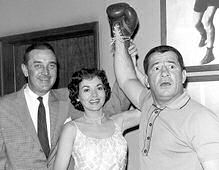
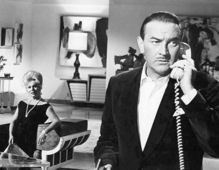 Above left: Star Lee Bowman en pretty Jil Jarmyn raise Rocky Graziano's mitt in victory as his pugilistic prowess convinces some dirty gamblers to return the jewels they conned out of a wealthy matron in the episode "Triple Cross" on Miami Undercover (Syndicated, March 8. 1961) Above right: Eva Gabor and Lee Bowman in Youngblood Hawke (Warner Bros., Nov 4. 1964). |
|
|
After this Bowman
retired from the screen with the occasional exception such as a role in
the movie Youngblood Hawke (Warner Bros., Nov 4. 1964) and the
role of Ted
Langer on TV in The Fugitive episode:
"Detour on a Road Going Nowhere"
(ABC, Dec 8. 1964). Beautiful
Elizabeth Allen offers
Kimble a one-night stand but Kimble refuses. Later
on a bus fellow traveler Langer (Bowman) finds Elizabeth more than a little
enticing. Elizabeth tells Kimble watch this and crosses her legs letting her
skirt rise. Kimble looks away but
Langer
practically breaks his neck trying to get a good look. Elizabeth then
demurely uncrosses her legs and pulls her skirt down and smugly smiles at
Kimble. Langer's wife (40's movie star Phyllis Thaxter) has seen what
happened and it is clear Langer will have some explaining to do. Elizabeth
tells Kimble that he may be like Langer in a ten years, dreaming of the
"legs that got away." Reportedly Lee gave up acting after a disastrous experience with Elaine Stritch in an off-Broadway production of Private Lives in 1968. |
|
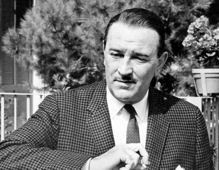 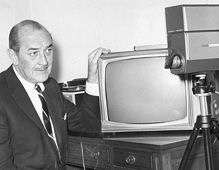 Above left: Lee Bowman guested as Charles Grattner, in "Fall of the Skylark - The Trial," a two-parter involving a gambling ring operating from within a plush motel, in TV's Judd for the Defense, (ABC, Jan 5. - 12. 1968). Above right: Lee Bowman counsels GOP candidates on making the most of TV appearances (Aug 23. 1970) |
|
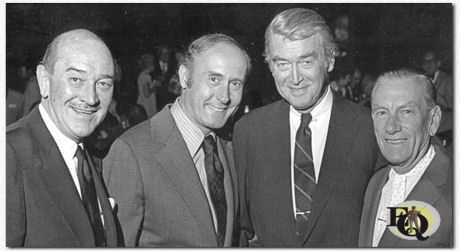 Above: Standing here (L to R) Lee Bowman, Henry Mancini, Jimmy Stewart and Hoagy Carmichael at a salute to Hoagy Carmichael, in Los Angeles, sponsored by the Indiana University Alumni Association, 1973. |
|
|
Living in Mandeville Canyon in Los Angeles he remained friends with Cesar Romero (owner of a low-priced men's clothing store in Los Angeles), John Payne, and Steffi Duna, the widow of his close friend Dennis O'Keefe. After his role in The Fugitive (ABC, Dec 8. 1964) for five years he became the radio and TV consultant in Washington. After Bowman's speech in a 1946 a lifelong friendship had ensued between the actor and the Nixon culminating in Bowman taking emcee jobs at the 1968 and 1972 Republican national conventions and subsequent inaugural balls, and a 1969 media consulting post with the National Republican Congressional Committee that gave him use of a Capitol Hill office. This was followed by a consultant job for Bethlehem Steel, coaching politicians and businessmen in speaking and on-camera techniques. From 1974 until his death, he was Chairman of the Kingstree Group, an international consulting firm, which offers communication advice to business and political leaders all over the world. Kingstree's global headquarters is now located in London, England. Bowman was responsible for developing the 'conversational' approach to spoken communication, which is recognized today as the only successful model for business and political presentations and media interviews. Asked if he missed acting he replied: "Not a bit. The only thing my job lacks now is billing. The rest is all there - famous people, travel, and some egos that would put my contemporaries to shame." Lee died, 3 days before officially becoming a senior citizen, in Brentwood, Los Angeles of a heart attack on December 25. 1979. Helene Rosson Bowman passed away on April 6. 1993, aged 78. |
|
|
Notes: * Another source said he'd left Cincinnati for Princeton, and discarded Princeton for the New York Academy of Dramatic Arts. All dates for movies are for the first US release. All dates for TV programs are original first airdates. All dates for (radio) plays are for the time span the actor was involved. Facts in red still need confirmation. |
|
|
Click on Uncle Sam if you think you can help out...!
|
|
|
Other references
Additional video & audio sources
|
|
|
This actor profile is a part of
Ellery Queen a website on deduction.
The actor above played Ellery Queen in
an Ellery Queen TV series.
Click Uncle Sam if you think you can help
out...! Many of the profiles on this site have been compiled after very careful research of various sources. Please quote and cite ethically! |
|
|
Page first published before October 19. 2017 Version x2.1 - Last updated April 22. 2025 |
|
 b a c k
t o L i s t o f S u s p
e c t s
b a c k
t o L i s t o f S u s p
e c t s
|
|
| Introduction | Floor Plan | Q.B.I. |
List of Suspects | Whodunit? | Q.E.D. | Kill as directed | New | Copyright Copyright © MCMXCIX-MMXXV Ellery Queen, a website on deduction. All rights reserved. |